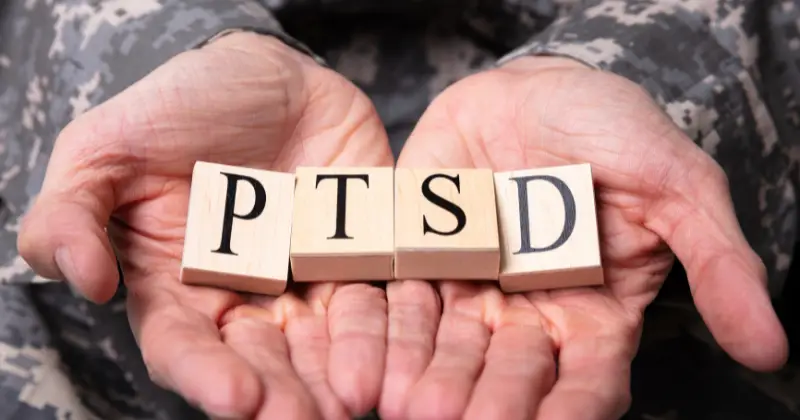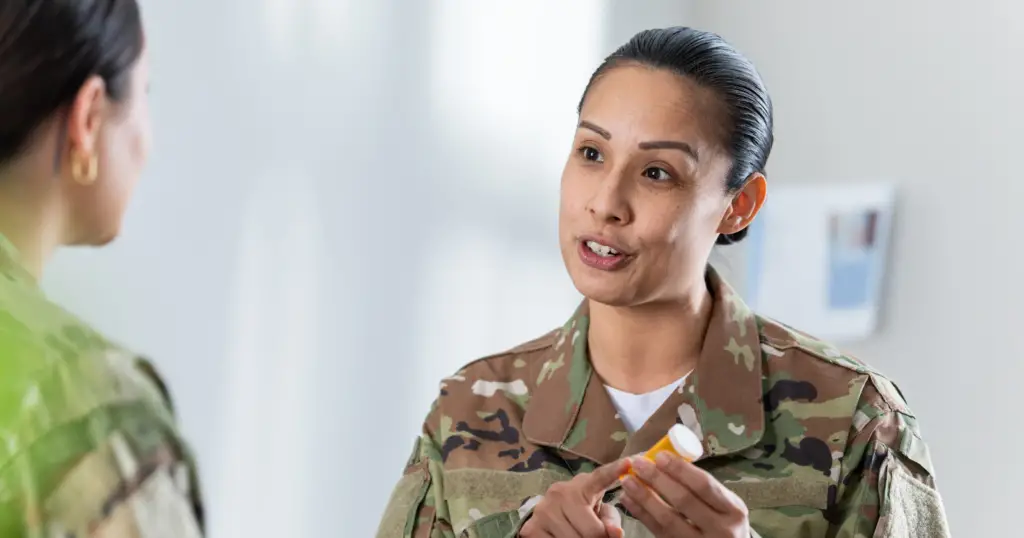Navigating the world of post-traumatic stress disorder (PTSD) can be challenging, especially when it comes to understanding the intricacies of secondary claims to PTSD. In this article, we will delve into the complexities surrounding these secondary claims, shedding light on how they affect compensation and treatment options for those affected. By gaining a deeper understanding of secondary claims, you can better support individuals coping with PTSD and help them on their path to recovery.

As a veteran who served on active duty in the Marine Corps from 1986-1995, including participating in Desert Shield and Desert Storm, I encountered traumatic experiences that left a lasting impact on my life. Today, I’ve noticed that the PTSD resulting from those experiences has a ripple effect on not only my emotional health but also my physical well-being.
Some of the most prevalent secondary conditions of PTSD include migraine headaches, central sleep apnea secondary, gastroesophageal reflux disease (GERD), and irritable bowel syndrome (IBS) [source]. By understanding the connections between these conditions and PTSD, we can address them more effectively, thereby improving the overall well-being of individuals like myself living with PTSD. In the subsequent sections, we will delve deeper into each of these secondary conditions and examine how they may manifest in someone with PTSD.
Understanding PTSD

Symptoms and Severity
As someone who has studied PTSD, I know that Post-Traumatic Stress Disorder (PTSD) can have a huge impact on a person’s life. The mild or transient symptoms of PTSD can be quite severe, with both physical and emotional effects. One thing that I noticed is that people with PTSD often experience feelings of irritability and difficulty sleeping.
PTSD symptoms can be grouped into four main categories:
- Re-experiencing the traumatic event: This can include flashbacks, nightmares, and intrusive memories.
- Avoidance: People with PTSD may avoid situations, places, or people that remind them of the trauma.
- Negative changes in mood and thoughts: This can include feelings of guilt, shame, or hopelessness, as well as a loss of interest in activities they used to enjoy.
- Hyperarousal: This includes being constantly on guard, feeling jumpy or easily startled, and having difficulty concentrating.
Here is a valuable informational video:
Mental Health Condition
I learned that PTSD is a mental health condition that can develop a few weeks after someone experiences a traumatic event. As a result, people with PTSD might experience ongoing stress reactions even long after the event has passed. The severity of the symptoms can vary from person to person, but in many cases, they can disrupt daily life.
It’s important not everyone to remember that PTSD isn’t something that people choose to have. It’s a serious condition that requires understanding and empathy from those around them. Mental health professionals can provide support and treatment options for people dealing with PTSD, with treatments including therapy and medication. By seeking help, those affected by PTSD can work towards overcoming their symptoms and regaining control over their life.
In conclusion, understanding PTSD, its symptoms, severity, and how it impacts someone’s mental health is crucial for both the affected person and their support network. By recognizing the signs and seeking professional help, it’s possible to manage and even overcome the challenges associated with PTSD.
Secondary Claims Process

Service Connection Requirements
As a veteran, I need to meet specific requirements for my disability to be considered service-connected ptsd. First, I must have served on active duty, active duty for training, or inactive duty for training. Second, I must have a current disability, and finally, there should be evidence showing a link between my service and the current disability.
Secondary Service Connection
Now, the secondary service connection occurs when I have a disability resulting from or worsened by an existing, secondary service connection related well-connected condition. This means that since leaving the military, I may develop new health problems related to my service-connected disabilities other medications. For instance, if I have PTSD, then the secondary conditions of PTSD could include migraine headaches, depression, sleep apnea, GERD, IBS, and ED.
To start the claim process for a secondary service connection, I must first ensure that my primary condition is recognized as service-connected. Next, I need to provide medical evidence, like a doctor’s report, indicating that my secondary service connections or condition is linked to my service-connected disability.
VA Disability Compensation
As a veteran with a service-connected disability, I’m eligible for VA disability compensation. This compensation is a tax-free, monthly benefit that takes into account the severity of my disabilities through percentage ratings.
For secondary conditions, the VA will also assess the severity using the same rating system. The combined rating for my primary and secondary conditions determines my overall disability compensation.
Here’s a brief overview of the secondary claims process:
- Identify secondary conditions linked to my service-connected disability.
- Gather medical evidence to support the connection between the primary and secondary conditions.
- File a claim with the VA, including completed forms and supporting medical documents.
- Await the VA’s decision on my claim and confirmation of the secondary service connection.
- If approved, receive VA disability compensation based on my combined disability rating.
By understanding the secondary service connected disability claims process, I can navigate the VA system and obtain the benefits I’m entitled to for both primary and secondary service-connected disabilities.
Common Secondary Conditions

Mental Health Disorders
In my experience, there are several mental health disorders that are often secondary to PTSD. For instance, anxiety and depression are quite common. I find that these conditions can be aggravated by the symptoms of PTSD, making it even more difficult for a person to cope with daily life. It’s important to recognize these secondary mental health conditions and seek proper treatment for them.
Physical Health Disorders
Along with mental health disorders, PTSD can also lead to various physical health issues. For example, migraine headaches or post traumatic headaches seem to be a recurring problem for those suffering from PTSD. I also notice that sleep disorders like sleep apnea and obstructive sleep apnea are quite common in people recover from. It’s crucial for individuals with PTSD to prioritize their sleep health to avoid further complications from mental disorders.
Additionally, gastrointestinal issues such as GERD and IBS are often seen as secondary conditions to PTSD. In my child, case, the stress and anxiety from PTSD can exacerbate these conditions, causing more discomfort and difficulties in daily life.
Some other physical health disorders include:
In conclusion, it’s evident that PTSD can lead to a range of secondary mental and physical health conditions. As someone who experiences these issues, I find it essential to address each secondary mental illness condition alongside PTSD to improve overall well-being.
Supporting Evidence and Documentation

Medical Diagnosis and Treatment
When I’m filing a secondary claim for PTSD, it’s essential to provide proper documentation and evidence to support my case. The first thing to consider is the medical diagnosis and treatment I’ve received. As a claimant, it’s crucial to gather all the relevant medical records that show my PTSD symptoms and any treatment I’ve received. This can include:
- Doctor’s notes and assessments
- Prescriptions and medication records
- Records of therapy sessions
- Hospitalization or emergency room records
Having this solid foundation of medical evidence will help establish the severity and impact of my PTSD on my daily life.
Independent Medical Opinion
In addition to the records from my treating doctor, it can be helpful to obtain an independent medical opinion (IMO) from another medical professional. This can help provide a clearer picture of my condition and validate my diagnosis. When seeking an IMO, it’s important to find a qualified medical professional, preferably with expertise in PTSD or mental health. The IMO should include:
- The doctor’s evaluation and opinion on my diagnosis
- Their assessment of the potential causes or triggers of my PTSD
- Opinions on the effectiveness and necessity of current and future treatment
This objective medical opinion can strengthen my case by providing an unbiased perspective on my condition.
Nexus Letters
Another vital component of my secondary PTSD claim is obtaining nexus letters from medical professionals. These letters help establish a clear connection between my PTSD and my primary disability or service-connected injury.
To craft a credible medical nexus letter, the medical professional should:
- Clearly explain the relationship between my PTSD and primary disability
- Provide evidence or research that supports this connection
- Offer their professional opinion on whether my PTSD is proximately due to or aggravated by the primary disability
A well-written nexus letter can significantly contribute to the success of my secondary PTSD claim, as it demonstrates the logical connection between my PTSD and service-connected condition, backed by medical opinion and evidence.
In summary, to support my secondary PTSD claim, it’s essential to gather relevant medical evidence, such as diagnosis and treatment records, obtain an independent medical opinion, and secure strong nexus letters that establish the connection between my PTSD and primary disability. By providing this documentation, I can make a compelling case and increase my chances of a favorable outcome.
Military Service and PTSD
As a veteran, I’ve experienced firsthand how military service can lead to posttraumatic stress disorder (PTSD) in service members. PTSD can result from various traumatic events that occur during military service, and the VA recognizes different types of secondary claims related to PTSD. Let me share with you a few sub-sections that delve into some specific aspects of PTSD in the military.
Combat and Non-Combat Traumatic Events
During my time in the military, I witnessed both combat and non-combat traumatic events. In combat situations, service members may experience PTSD resulting from traumatic experiences:
- Direct engagements with the enemy
- Witnessing the death and injury of comrades or civilians
- Surviving attacks or improvised explosive device (IED) explosions
Non-combat traumatic events can also lead to feelings related to PTSD. Examples include:
- Training accidents
- Vehicle accidents
- Natural disasters during deployment
Irrespective of the nature of the traumatic event, these experiences can have lasting effects on mental health and result in PTSD for some service members and war veterans.
Sexual Trauma and Assault
Unfortunately, military sexual trauma and assault are prevalent in the military. I’ve seen many comrades struggle with the aftermath of such incidents. Sexual trauma can include any unwanted sexual experience, abuse, or harassment that occurs during military service and isn’t limited to combat zones.
If a service member experiences PTSD due to sexual assault, the VA requires them to submit VA Form 21-0781a to support their claim. This form allows the VA to assess the veteran or family member’s eligibility for va disability benefits and health care services.
Filing a claim for PTSD based on a personal assault may require additional documentation or evidence to substantiate the incident. The process can be emotionally challenging, but the resources offered by the VA and the National Center for PTSD can greatly help individuals through their journey toward recovery.
As a veteran, I can attest to the impact of traumatic events on the mental health of my own family member and many service members. Recognizing and seeking help to address these events is crucial for the well-being of our troops and veterans.
Additional Information and Resources

Function and Lifestyle Impact
As someone who has experienced PTSD, I know that it can have a significant impact on daily functioning, sleep problems, and overall lifestyle. PTSD can lead to mental illnesses and difficulties in both personal and professional life. Some common secondary conditions associated with PTSD include migraines, sleep disorders, erectile dysfunction, and chronic respiratory failure.
- Migraines can severely affect day-to-day activities, making it difficult to work or enjoy life.
- Sleep disorders, such as sleep apnea, can cause issues with energy levels and overall health.
- Erectile dysfunction (ED) can lead to relationship problems and lowered self-esteem.
- Chronic respiratory failure can require the use of devices like CPAP machines or a tracheostomy, further impacting daily life.
Seeking Help and Support
It’s essential for those struggling with PTSD to seek help from professionals, such as psychiatrists or other mental health providers. Additionally, it’s crucial to stay informed about available resources, including compensation and benefits for service-connected disabilities and illnesses like PTSD.
Some possible benefits for veterans include VA disability compensation and support for secondary conditions related to PTSD. These benefits can help cover the costs of treatment, medications, and necessary lifestyle accommodations.
Don’t hesitate to reach out to local support groups or online forums where individuals with similar experiences can offer encouragement and advice.
Remember, you’re not alone in this journey, and seeking help is an essential step toward healing and reclaiming your life.

